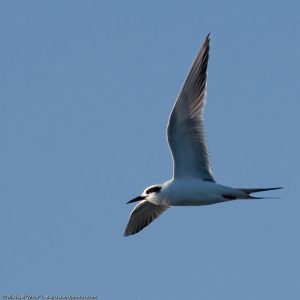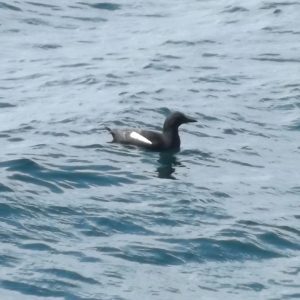
Forster’s Tern have been seen along the Maine Coast from southern Maine to Thomaston and all the way to Eastport. (Photo by Mike Baird courtesy of Wiki Commons)
Like many an adventurer, we took time out of our weekend to observe the drama of the surf riled up by Hurricane Erin passing far offshore—of course, with the hope of seeing nice birds. On Friday, we zipped over to Pemaquid Point and saw…a Black Guillemot. One of our favorite little seabirds, but nothing out of the ordinary; we see guillemots at Pemaquid regularly. Other than a few eiders and gobs of tourists, that was about it. The surf, as you’d expect, was magnificent.
Next day, off we went to our old haunts in southern Maine, again to enjoy surf and birds. First, we meandered through the more sheltered Goose Rocks Beach, more for old times’ sake. As expected, the sea wasn’t nearly as wild as Pemaquid except out around and beyond Timber Point; we hoped no one was trying to surf out there, as the breakers were violently frothy.

Hurricane surf along Fortune’s Rocks Beach in Biddeford, where the authors spent some time birding over the weekend. (Photo by Allison Wells)
From there, it was Fortune’s Rocks Beach, in Biddeford, another favorite old haunt from our days as grad students spending summers in Kennebunk and surrounding areas. The surf here did not disappoint; it was a constant, deafening roar. We set up a scope between the stone barriers put in place to provide some protection for the roads and homes during violent coastal storms.
The water churned foamy white under late-day sunny blue skies. The light winds gave no indication that a massive hurricane was passing hundreds of miles to the East.
Just a hundred yards offshore, behind where the waves were breaking, a group of about 30 Common Terns, adults and juveniles, flew in a loose line, scanning the water for prey. When they reached the end of the beach, they would turn and zoom back up the other way to repeat their route. It was especially great to see the juvenile birds, distinctive with their dark bar across the front of the wing, knowing that they had been hatched this summer and would be back to nest themselves in a couple of years.

Along the Forster’s Terns, the authors watched a flock of about 30 Common Terns, flying up and down the beach at Fortune’s Rocks in Biddeford. (Photo by PDidisheim/NRCM)
We scanned through the terns, enjoying the sight as we listened to the roar of the surf and breathed in the salt-laden air. Then we noticed a different tern among the commons—a tern with a black mask contrasting with a white head and nape and only a little black on the outer part of the gray upperwing. It was a Forster’s Tern. As we continued watching we realized that there were two more traveling with it—three Forster’s Terns!
Forster’s Terns don’t nest in Maine, but a few show up on the Maine coast (especially the southern Maine coast) in late summer and early fall every year. This year, there seems to be a good number of them around the coast south of Portland, with a few scattered north including in Thomaston Harbor and off Eastport.
Forster’s Terns have a very interesting breeding distribution, with populations nesting inland from south-central Canada into the Great Plains, western Great Lakes, and western U.S. Birds also nest along the coast in California, the mid-Atlantic states, and the Gulf Coast into northern Mexico. Unlike many of our other breeding terns that go much farther south, Forster’s Terns winter from the southern U.S. south to Costa Rica and Panama and to Bermuda.

A Black Guillemot was about the only bird the authors saw while visiting Pemaquid Point as the Hurricane Erin passed far offshore. (Photo courtesy of authors)
Where the Forster’s Terns come from that make their way to Maine in late summer is a mystery. Are they coming north from the mid-Atlantic? Or do they originate in inland breeding colonies far to the West? Forster’s Terns even show up with regularity in the British Isles in late fall and winter. Do some of the birds we see in Maine just keep going east until they cross the Atlantic?
Just to be clear, Forster’s Terns are not a species we expect to be swept up in hurricanes and taken far off course like tropical terns sometimes are. The Forster’s Terns that are being seen this summer are part of a normal but interesting pattern that delights birders, even if we don’t understand exactly what it’s all about.
Incidentally, we just discovered that the so-called type specimen (the specimen from which the species was first described to Western Science), was procured from one of the world’s largest inland freshwater deltas, the Saskatchewan River Delta that stretches across the Saskatchewan-Manitoba border and is a hugely important place for birds.
Our hurricane surf and birding adventures reminded us how fortunate we are to live in Maine, where our coast is spectacular and the birding is always special.
—Jeff and Allison Wells














Leave a Reply